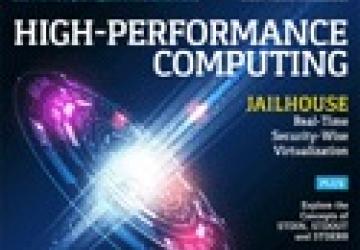April 2015 Issue of Linux Journal: High-Performance Computing

.png)
High Performance: a Relative Term
My Pebble watch has several orders of magnitude more power than the mainframe computers used by NASA to land astronauts on the moon and then get them back safely. In fact, at the time, the six-megabyte program IBM developed to monitor the astronaut's biometric and environmental data was the most complex software ever written! Times certainly have changed, but our desire to push computing to its very limit surely hasn't. This month is the High-Performance Computing issue of Linux Journal, and whether you plan to land humans on the moon or analyze weather data over the Atlantic, this issue should tickle your fancy.
We start out with Django templates, as Reuven M. Lerner builds on last month's column about the "atfproject" he started. Whether you want to develop with Django or not, Reuven's lessons always are beneficial to the new programmer and the seasoned developer alike. Dave Taylor follows with a topic that is half scripting and half brain teaser. How can you make a script to create the words in a word search? Is a brute-force, every possible iteration solution the best way? Dave starts the script this month and urges us to send him ideas.
Kyle Rankin continues last issue's article on Libreboot. We deal with the operating systems (specifically Linux!) all the time, but Kyle dives deeper and explains how to replace the system BIOS with an open alternative. My column isn't nearly as low-level, but it addresses an often confusing concept for Linux users—namely, system I/O. If STDIN, STDOUT and STDERR sound scary, fear not. I explore I/O in all its glory and round things out with a clearer understanding of pipes and redirects too.
You will get a really clear look at LUCI4HPC this month, as Melanie Grandits, Axel Sündermann and Christ Oostenbrink explain the lightweight clustering system. Although clustering often is needed only in specialized circumstances, it doesn't mean the process needs to be difficult. With a friendly Web interface and high customization ability, LUCI4HPC might be perfect for your needs.
Valentine Sinitsyn describes how to use Jailhouse this month. Although it might seem like "just another virtualization platform", Jailhouse is designed with real-time virtualization in mind. For folks in system automation, medical and telecommunications, real-time Linux is crucial. Sadly, most virtualization systems don't handle real-time solutions very well. If you need real-time solutions, but want the cost benefits of virtualization, Jailhouse might be perfect.
Finally, Doc Searls tears open the "Do Not Track" concept and explores its meaning, intent, current state and future. If you, or your users, are concerned about who gets access to what data, Doc's column will be of particular interest this month.
In fact, as a Linux user, this entire issue is full of articles that most likely will pique your interest. Whether you want to rewrite the BIOS on your laptop or just want some free cash (be sure to read my UpFront article on ChangeTip), this issue aims to please. Add the product news, tech tips, kernel updates and so on, and you have on your screen a great way to spend April 1st—no fooling!
Available to Subscribers: April 1










